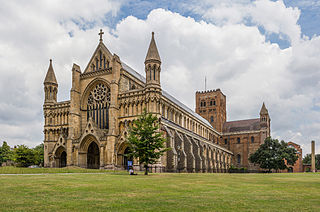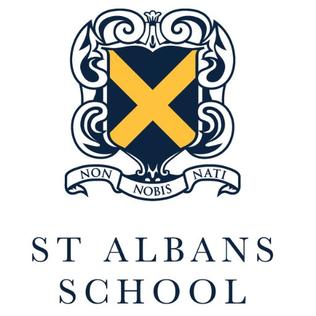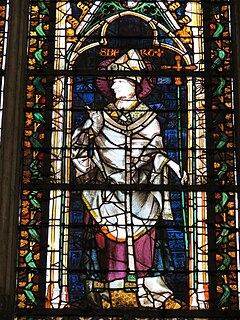Related Research Articles

St Albans Cathedral, officially the Cathedral and Abbey Church of St Alban but often referred to locally as "the Abbey", is a Church of England cathedral in St Albans, England. Much of its architecture dates from Norman times. It ceased to be an abbey following its dissolution in the 16th century and became a cathedral in 1877. Although legally a cathedral church, it differs in certain particulars from most other cathedrals in England, being also used as a parish church, of which the dean is rector with the same powers, responsibilities and duties as that of any other parish. At 85 metres long, it has the longest nave of any cathedral in England.

Louis VIII, nicknamed The Lion, was King of France from 1223 to 1226. From 1216 to 1217, he invaded and claimed the Kingdom of England. Louis participated in the Albigensian Crusade in southern France, driving it to its successful and deadly conclusion. He was the only surviving son of King Philip II of France by his first wife, Isabelle of Hainaut, from whom he inherited the County of Artois.

Aldhelm, Abbot of Malmesbury Abbey, Bishop of Sherborne, and a writer and scholar of Latin poetry, was born before the middle of the 7th century. He is said to have been the son of Kenten, who was of the royal house of Wessex. He was certainly not, as his early biographer Faritius asserts, the brother of King Ine. After his death he was venerated as a saint, his feast day being the day of his death, 25 May.

Matthew Paris, also known as Matthew of Paris, was an English Benedictine monk, chronicler, artist in illuminated manuscripts and cartographer, based at St Albans Abbey in Hertfordshire. He wrote a number of works, mostly historical, which he scribed and illuminated himself, typically in drawings partly coloured with watercolour washes, sometimes called "tinted drawings". Some were written in Latin, some in Anglo-Norman or French verse.
Roger of Wendover, probably a native of Wendover in Buckinghamshire, was an English chronicler of the 13th century.
Alexander Neckam was an English magnetician, poet, theologian, and writer. He was an abbot of Cirencester Abbey from 1213 until his death.
Archibald Campbell, 4th Earl of Argyll or Archibald "the Red" Campbell, was a Scottish nobleman and politician.
John Whethamstede was an English abbot and one of the leading literary figures in fifteenth-century England.

St Albans School is a public school in the city of St Albans in Hertfordshire, in the South East of England. Pre-sixth form admission is restricted to boys, but the sixth form has been co-educational since 1991. Founded in 948 by Wulsin, St Albans School is the oldest school in Hertfordshire and one of the oldest schools in the world. Nicholas Carlisle, in 1818, described the school as "of very ancient origin, and of great celebrity" and the Good Schools Guide describes St Albans as a "traditional public school, with a rich history".

Fulk FitzWarin, variant spellings, the third, was a prominent representative of a marcher family associated especially with estates in Shropshire and at Alveston in Gloucestershire. In young life, early in the reign of King John (1199–1216), he won notoriety as the outlawed leader of a roving force striving to recover his familial right to Whittington Castle in Shropshire, which John had granted away to a Welsh claimant. Progressively rehabilitated, and enjoying his lordship, he endured further setbacks in 1215–1217.

John of Wallingford, also known as John de Cella, was Abbot of St Albans Abbey in the English county of Hertfordshire from 1195 to his death in 1214. He was previously prior of Holy Trinity Priory at Wallingford in Berkshire, a cell of St Albans.

Ansbert, sometimes called Ansbert of Chaussy, was a Frankish monk, abbot and bishop of Rouen, today regarded as a saint in the Catholic Church.
William of Wallingford was the 47th abbot of St Albans Abbey. He was a Benedictine monk at Holy Trinity Priory, Wallingford, Berkshire, England and like John of Wallingford and Richard of Wallingford, moved from this cell of St Albans Abbey to the abbey itself. He was a favourite of John Stoke, 44th abbot of St Albans, also from Wallingford. On his deathbed in 1451, Stoke was supposed to have given William and Thomas Wallingford, his senior chaplain, charge over 1000 marks but after his death they could only account for 250 marks. The abbot John Wheathampstead who succeeded Stoke suspected the two over the money. Nevertheless, William of Wallingford was later appointed abbot in 1476, after the death of William Albone, apparently for his financial acumen, at a time when the abbey was in debt. William of Wallingford managed to get rid of the debt whilst also spending on the abbey. He built the high altar known as the Wallingford Screen at a cost of £733 and completed the chapter house. The statues on it were destroyed during the Dissolution but were replaced in Victorian times.
Ælfric of Abingdon was a late 10th-century Archbishop of Canterbury. He previously held the offices of abbot of St Albans Abbey and Bishop of Ramsbury, as well as likely being the abbot of Abingdon Abbey. After his election to Canterbury, he continued to hold the bishopric of Ramsbury along with the archbishopric of Canterbury until his death in 1005. Ælfric may have altered the composition of Canterbury's cathedral chapter by changing the clergy serving in the cathedral from secular clergy to monks. In his will he left a ship to King Æthelred II of England as well as more ships to other legatees.
Events from the 1210s in England.

Kings Langley Palace was a 13th-century Royal Palace which was located to the west of the Hertfordshire village of Kings Langley in England. During the Middle Ages, the palace served as a residence of the Plantagenet kings of England. It fell into disuse sometime during the 16th century and became a ruin. Today, nothing remains of the building except for some archaeological remains. The site is a scheduled ancient monument.

Louth Park Abbey was a Cistercian abbey in Lincolnshire, England. It was founded in 1139 by the Bishop Alexander of Lincoln as a daughter-house of Fountains Abbey, Yorkshire.

John of Wallingford was a Benedictine monk at the Abbey of St Albans, who served as the abbey's infirmarer at some time between c.1246-7 and his death in 1258. He is now mostly known through a manuscript containing a miscellaneous collection of material, mostly written up by Wallingford from various works by his contemporary at the abbey Matthew Paris, which survives as British Library Cotton MS Julius D VII. This manuscript includes the so-called Chronica Joannis Wallingford or Chronicle of John of Wallingford.

Sir John Russell of Kingston Russell in Dorset, England, was a household knight of King John (1199–1216), and of the young King Henry III (1216–1272), to whom he also acted as steward. He served in this capacity as custodian of the royal castles of Corfe and Sherborne (1224) in Dorset and of the castles of Peveril and Bolsover in Derbyshire. He served as Sheriff of Somerset in 1223-1224. He was granted the royal manor of Kingston Russell in Dorset under a feudal land tenure of grand serjeanty. Between 1212 and about 1215 he acquired a moiety of the feudal barony of Newmarch, the caput of which was at North Cadbury, Somerset, in respect of which he received a summons for the military service of one knight in 1218.
Hodierna of St Albans was the mother of Alexander Neckam and wet nurse of Richard I of England. Hodierna is also known as Audierne.
References
- 1 2 Rose, Hugh James (1857). "Alexander, le Pargiter". A New General Biographical Dictionary. Vol. 1 AA–ANS. London: B. Fellowes et al. p. 287.
- ↑ Hardy, Thomas Duffus (1871). Descriptive Catalogue of Materials Relating to the History of Great Britain and Ireland. Vol. 3. Longman. p. 62.
- ↑ Russell, Josiah C. (April 1932). "Alexander Neckam in England". The English Historical Review. 47 (186): 264. JSTOR 553364.
- ↑ Russel, Josiah Cox; Hieronimus, John Paul (1935). "The Shorter Latin Poems of Master Henry of Avranches Relating to England" (PDF). The Mediaeval Academy of America, Studies and Documents (1). Retrieved 17 March 2020.